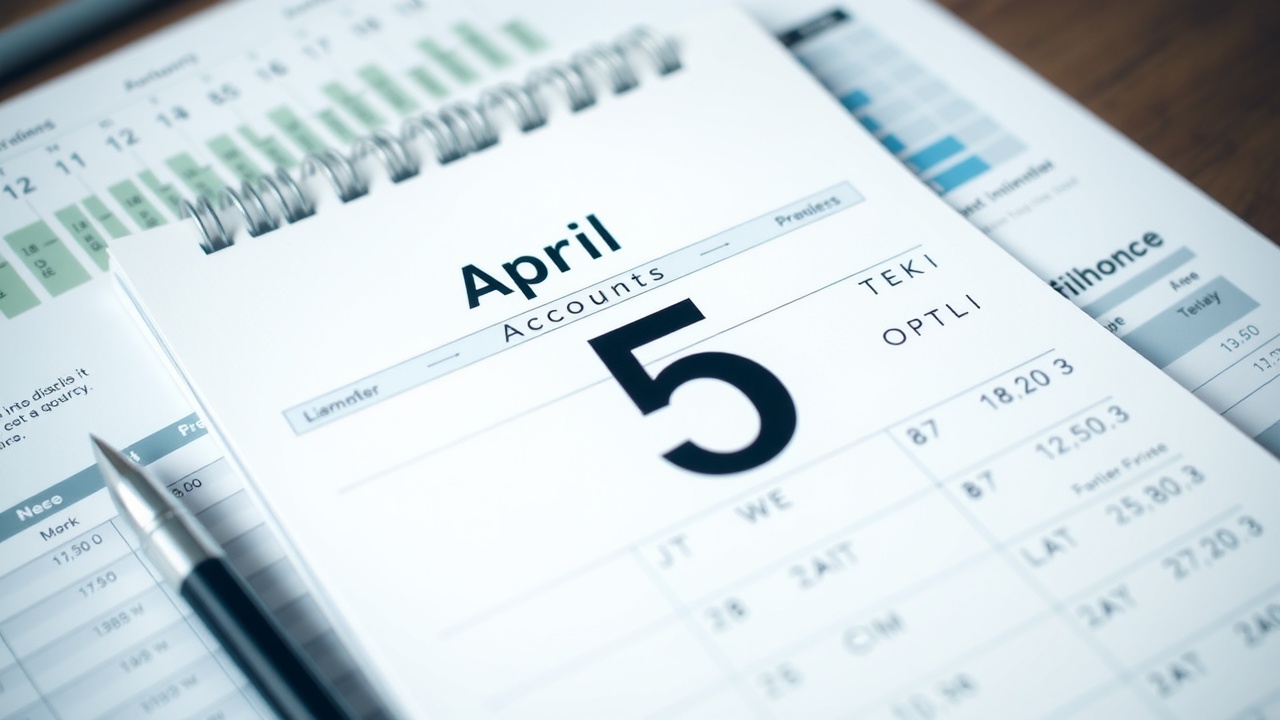
The 2024–2025 fiscal year is rapidly coming to an end
We've created a plan of action to help you make the most of important tax benefits and deductions before they expire on April 5 at midnight.
There is not much time left for investors and savers to take advantage of significant tax benefits before the 2024 - 2025 tax year ends.
The current tax year ends at midnight on April 5, 2025, and the new 2025 - 2026 tax year starts. Some allowances will be permanently lost.
"It's crucial to make sure that your financial affairs are in order as the tax year-end draws near so that you can take advantage of any remaining reliefs, allowances, and exemptions before they are lost," says Alex Johnston, wealth planner at Succession Wealth.
Time is of the essence because many providers will have deadlines for receiving applications for top-up plans like pensions or ISAs, he continues.
It's also critical to take advantage of tax breaks and save as much money as possible before "awful April" hits, when a number of price increases will be implemented, ranging from council tax to energy and water bills.
The Spring Statement, which is scheduled for March 26 and could be used by Labour to announce tax changes, adds uncertainty this year. Rumor has it that later this year, a reduced cash Isa limitpossibly from 20,000 to 4,000will be announced.
In order to help you maximize your tax deductions and enable your money to grow even more, we have created a helpful checklist.
1. Make use of your ISA funds
Many people refer to the 20,000 ISA limit as a "use it or lose it" allowance. This implies that, each tax year, you can pay up to £20,000 into all of your ISAs (with the exception of the junior ISA, which has a separate £9,000 cap), but you are unable to carry over any unused allowances to the following year.
Innovative finance ISAs, lifetime ISAs, cash ISAs, and stock and share ISAs are all eligible for the £20,000 allowance.
By investing your money in an ISA, you shield yourself from paying any income tax, dividend tax, or capital gains tax (CGT) on any profits, interest, or income you earn. To avoid taxes, it might be worthwhile to transfer savings into a cash ISA and investments into a stocks and shares ISA.
You can always "park" the money in a cash fund and make a decision later if you want to open an ISA for stocks and shares but are unsure where to invest it.
2.
Execute a "bed and ISA." Because the capital gains tax and dividend tax-free allowances have more than covered any income or profits, you might not have had to worry about paying tax on investments held outside of an ISA in the past.
Both of these benefits, though, have recently decreased, so you might receive an unexpected tax bill.
This tax year, the tax-free dividend allowance decreased from £1,000 to £500. HMRC predicts that this will result in over 1 million additional people having to pay dividend tax.
In the meantime, there is a 3,000 CGT tax-free allowance, which was 12,300 a few years ago.
By using a procedure called a bed and ISA transfer, investments can be moved into an ISA, shielding future profits and dividends from taxation.
It entails selling and repurchasing shares, which may result in a capital gains tax obligation. Basic-rate taxpayers now pay 18 percent on gains, while higher and additional-rate taxpayers pay 24 percent, as a result of the CGT rates being raised in the Autumn Budget on October 30 of last year.
Be careful not to realize a gain and pay these higher rates if you're doing a bed and ISA. You could benefit from both tax-free allowances and avoid paying CGT (or lower a possible bill) by selling some investments now and some in the 2025 - 2026 tax year.
3. Make a payment to your spouse
Transferring investments to your spouse or civil partner does not result in capital gains tax. As long as your spouse has some ISA allowance left over after using up their tax-free allowance this year, you can take full advantage of those tax benefits.
When your partner comes to sell the asset, the original cost will be used, so make a note of that.
To maximize that tax break, you can transfer investments to your spouse, who also receives a 500 tax-free dividend allowance this tax year. This also applies to income-producing investments.
Additionally, there may be a double advantage. Your spouse's dividend or capital gains tax rate will be lower if they are in a lower income tax bracket.
4. With a Lifetime ISA, you can receive free money
Optimizing a Lifetime ISA can be one of the most effective strategies to maximize bonuses and allowances. Those under 40 years old can open them, and by making contributions of up to £4,000 per tax year, savers can receive a 25 percent government bonus, which can total up to £1,000 annually.
This money can be used for a first home, provided the purchase costs £450,000 or less, or it can be accessed penalty-free upon reaching 60.
5. The marriage allowance is yours to keep
The marriage allowance is given to couples in which one partner pays basic-rate income tax and the other partner either does not pay income tax at all or has an income below the 12,570 personal allowance. It could result in tax savings of up to £252 annually.
Currently, over 2 million couples take advantage of the tax break, which permits husbands, wives, and civil partners to give their higher-earning spouse a portion of their tax-free personal allowance.
HMRC calculates that over 2 million couples might be losing out on the savings, though.
Couples are eligible to receive an additional lump sum of up to 1,004 for the four tax years that they can backdate their claim by in addition to this year's allowance. It is imperative that you apply for the allowance by April 5th.
The non-taxpayer can apply for the allowance on the HMRC website. If completing the online application is difficult, you can apply by writing to HMRC or by self-assessment. Call 0300 200 3300 if you need assistance.
6. Make the most of your pensions
Tax relief is available if you contribute up to £60,000 to your pensions this tax year. Your yearly allowance is determined by your income. Paul Clifton, director of wealth management at Arbuthnot Latham, notes that "you can still contribute up to 2,880 each tax year, boosted by tax relief to 3,600" if you are under 75 and not employed.
Carry-forward rules are another way for pension savers to make sizable contributions. This enables you to make use of any unused tax benefits from the three prior tax years.
For small business owners who make significant cash profits, this could be especially profitable.
You may be eligible for an additional 20 percent or 25 percent in pension tax relief if you are a higher-rate or additional-rate taxpayer. Remember to claim the full amount of this relief.
Checking to see if you qualify could be very profitable because the tax collector has held onto 1 point 3 billion in unclaimed pension tax relief over the previous five years.
Pension contributions can lower your income tax band and are a tax-efficient way to save for retirement.
When you make a contribution to your pension fund, the gross amount of the contribution extends your basic-rate tax band. In the event that you are no longer a higher-rate taxpayer, your CGT and dividend tax rates may be reduced.
If you have just crossed over into the next tax bracket, you could save a lot of money by making a small pension contribution that would put you below the threshold.
Seven.
Minimize your inheritance tax obligation. You can lower your overall tax liability by taking advantage of a number of inheritance tax breaks.
The "annual exemption" is the most well-known and permits a gift of £3,000. Most importantly, if you have any leftover allowance from the previous year, you can use it to make a 6,000 gift.
Each partner in a couple receives the same 3,000 allowance, which could double the amount of IHT you can deduct.
Gifts up to £250 can be given to as many people as you like, provided that you haven't given them anything bigger.
According to Clifton, "You can give your loved ones financial security and lower future inheritance tax obligations by using allowances like junior ISAs and giving monetary gifts.
8. Provide your children with a pension or ISA
It is possible to contribute funds to the savings of others, including your children, in addition to your pension contribution allowances. This has the advantage of allowing children, even those who do not pay taxes, to still receive tax relief on the contribution.
It will only cost you 2,880 to invest the maximum amount of 3,600 per year on behalf of a child. This is because the taxman adds a top-up of 720 to your contribution.
Although it may seem strange to begin a pension for a child, it's a practical way to maximize tax savings and help guarantee that they have a retirement fund in later life. According to HMRC, 60,000 families established pension plans for children in 2019.
The same can be said for a junior ISA, though the child will have access to the fund much earlierbeginning at age 18. The account can receive up to 9,000 contributions from parents, friends, and family each tax year, and any profits from investments are tax-free. This allowance is "use it or lose it"it does not carry over into the following tax year, just like the adult ISA limit.
Junior ISAs come in two varieties, just like adult ISAs: cash ISAs and stocks and shares ISAs. If you're thinking about opening a junior account for stocks and shares but are feeling overwhelmed by the options, check out our guide to help you choose the right junior ISA.
Nine.
Verify your tax code. The tax collector may demand thousands of pounds in additional taxes if your tax code is incorrect. Thus, it's critical to verify your tax code.
The most popular tax code is 1257L, which is typically a combination of letters and numbers.
For the previous four tax years, you can claim back any overpaid taxes if you discover that you are on the incorrect tax code. You must, however, verify and notify HMRC if it is incorrect.
If a person's job changes or their salary increases or decreases, they may occasionally be on the incorrect tax code.
You should notify HMRC before the end of the tax year if you believe you have overpaid taxes through PAYE during the current tax year. For more details on how to submit a tax refund claim, visit gov.gov.uk.
10. .
Examine your child's benefits. Parental child benefits are given to assist with childcare expenses. While the rate for other children is 17.25 per week, it is 26.05 per week for the eldest or only child.
However, since they currently stop receiving child benefits when their income exceeds £60,000, parents need to be aware of the high income child benefit charge.
Individuals with incomes between £60,000 and £80,000 are required to repay a portion of their earnings through additional income tax.
Your taxable income may be lowered and you may be able to keep more of your child benefit if your income is just over £80,000.
One way to reduce your taxable income without losing money is to use employer salary sacrifice plans or contribute to a workplace pension.
A salary sacrifice agreement is a contract that lowers an employee's cash compensation in exchange for non-cash benefits such as childcare vouchers, pension contributions, or a cycle-to-work program.














Leave a comment on: Checklist: 10 simple steps to reduce your taxes before the 2024–2025 tax year ends